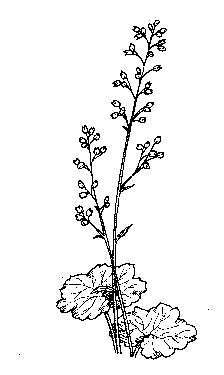Coralbells (Heuchera sp.)
 |
Originally from Mexico and our Southwest, Coralbells are sturdy perennial plants that bloom year after year. They hold a prominent place in many residential yards and gardens because they offer both delicate, long-blooming flowers and attractive foliage packaged in a tough, versatile plant. These qualities make them eminently suitable as a parent in many hybrid versions of Coralbells and in combination with other species as well. They are very easy to care for. Coralbells are at home through most of the continental United States, nearly to Canada (zones 3 through 8). They are hardy in areas where the winter temperatures do not fall below -35°F.
Size: Coralbells are between 1 to 2 1/2 feet tall, depending on the type. While their foliage may only be 8 or 10 inches tall, their delicately branching flower stems often reach 2 feet or more. An individual mature plant may grow into a 12 to 18 inch wide clump.
Foliage: Coralbells’ leaves have several lobes. They are usually rounded with scalloped edges, although those of the many hybrids of this plant are more sharply pointed, or even ruffled. Ranging from 3/4 to 2 inches across, depending on the variety, the leaves grow on stems directly from the base of the plant at soil level in a tight clump. They may be plain green or marbled with dark or silvery lines or patches. Some hybrid versions have wrinkled surfaces. The variety ‘Palace Purple’ has striking dark purple-bronze foliage with red undersides. ‘Pewter Veil’ has silvery leaves. Usually foliage is evergreen, surviving over the winter.
Flowers: Coralbells have delicate bell-shaped flowers. Only 1/4 to 1/3 inch long, they range in color from pink to rose and coral to crimson. Those of some hybrids are off-white. Nodding at the ends of many tiny stems which branch off the 10 to 20 inch main flower stalk, they appear in May or June. Plants will bloom well into July and often even longer if the dead stalks are routinely cut off. Because cool summer temperatures help to prolong flowering, coralbells may bloom longer in the North than in warmer southern climates. Typically they produce up to 20 or more stems of flowers in their second year. Subsequently, each plant will produce 50 or 60 flower sprays.

